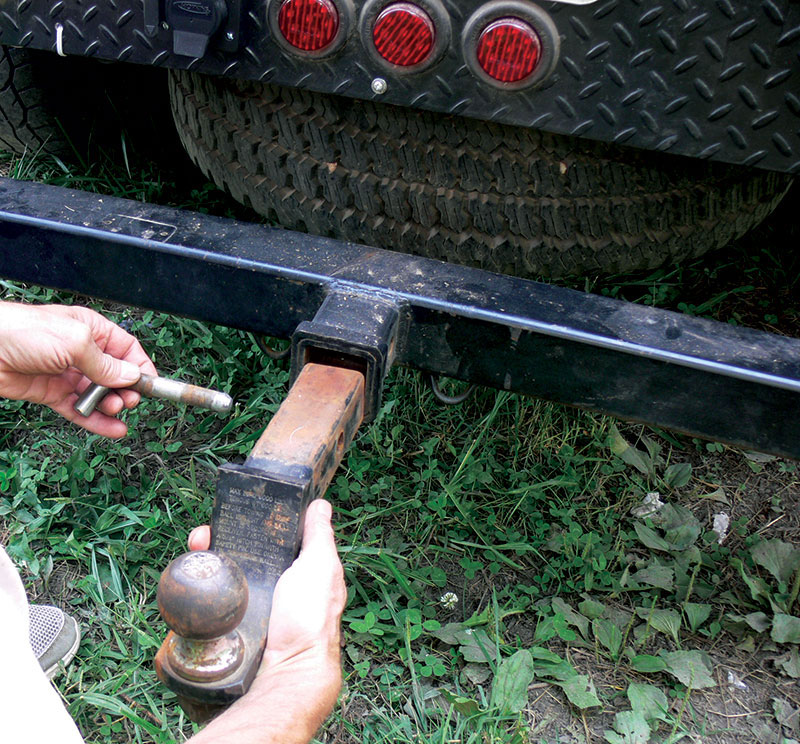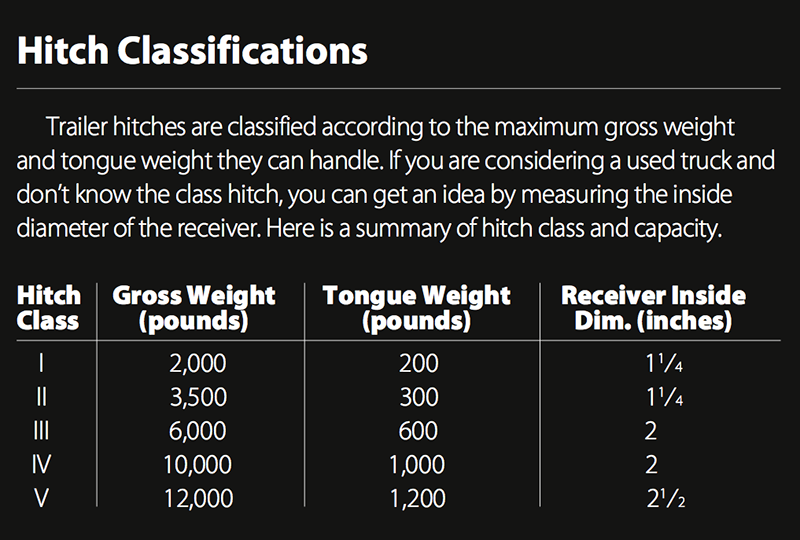
Running a farm involves moving things around. The load might be as small as a few 50-pound sacks of feed or as large as a 5-ton tractor. Pickup and flatbed trucks have handled such farm tasks for nearly a century. Although they might appear the same to the casual observer, trucks have different abilities when it comes to towing heavy trailers.
When choosing a farm truck for towing, some features can make the difference between a white-knuckle experience and a safe, easy trip. First, you need to consider the heaviest loads you will haul. The two important factors here are gross weight, which is the weight of the trailer plus the load, and tongue weight, which is the downward force that the trailer coupler places on the hitch ball.
For towing a gross weight of 2 tons or less, you can get by with a two-wheel-drive, half-ton truck or SUV with a category III receiver hitch. On the other hand, a loaded stock trailer with a gross weight of 12,000 pounds requires a more substantial category V, or gooseneck, hitch as well as a truck capable to pulling it safely.
The other consideration for towing is the tongue weight. Your vehicle’s suspension should be able to handle a tongue weight of about 10 percent of the trailer’s maximum gross weight.
Hitches
Trailer hitches come in two basic designs: receiver and gooseneck. Each has its advantages and drawbacks for towing.
1. Receiver
The hitch on the back of the truck, the receiver hitch, is firmly welded or bolted to the frame. Most farm trucks have receiver hitches, so you can lend your trailer to a neighbor—or rent or borrow one, in a pinch—and be good to go. Connecting the trailer to a receiver hitch is quick and easy and, depending on the rating, can haul as much as 6 tons.
Receiver hitches do, however, put the tongue weight behind the rear axle, which tends to lift the front wheels. Too much tongue weight can make the steering dangerously squirrely and cause the headlights to shine into the eyes of oncoming drivers, even when on the low-beam setting. Later in this article, I’ll discuss some of the suspension options that help with these issues.
The receiver hitch slides into the receiver on the truck (see photo above right) and is held in place with a pin for easy removal. The ball may be bolted or welded to the receiver hitch. The three standard ball sizes are 1 7/8, 2 and 2 5/16 inches. Make sure the ball size matches the trailer hitch; this size is usually stamped on the hitch.
Close isn’t good enough: A 2-inch trailer hitch will part ways with a 1 7/8-inch ball, and a 2 5/16-inch trailer hitch will come off of a 2-inch ball (voice of experience speaking here).
For easy switching, I have one receiver hitch with a 2-inch ball and one with a 2 5/166-inch ball, so that I can swap them out by pulling the pin that holds them in place. As an extra measure of safety, I spray painted the 2-inch hitch fluorescent orange as a reminder when hooking up the larger trailer.

2. Gooseneck
The next step up in hauling capacity is the gooseneck hitch. These trailers are mainly for a gross weight of more than 12,000 pounds. The gooseneck hitch positions the ball just forward of the rear axle, putting the tongue weight where the truck is designed for it. This adds to the traction without affecting steering, and it also improves the braking with less tendency to jackknife. Gooseneck trailers are also more maneuverable when backing into tight places. On the downside, they are a little more difficult to hook up, especially to a pickup truck with a tailgate, and they require a ball in the center of an otherwise flat pickup truck bed.
Truck Size
Truck weight classification is based on how much load can be safely hauled in the bed of the truck and indicates how heavily the truck is built. Half-ton trucks can pull as much as about 4 tons gross weight. They cost less and use less fuel than their bigger siblings, so this class is a good candidate for a truck that will double as a daily driver.
A three-quarter-ton truck is typically built on a heavier chassis and can pull about twice the load of a half-ton truck. This is the go-to truck for many farmers because it will do pretty much anything required of it. One-ton trucks are typically built on the same chassis as a three-quarter-ton truck but with a heavier suspension and duallies (a second pair of tires on the back). Fully outfitted for towing, they can pull more than 10 tons. On the down side, they are more expensive and tend to have poor fuel economy; plus, that second pair of tires is expensive when the time comes to replace them.
Engine Type
Choosing between gas and diesel engines is more a matter of preference than utility. Diesel engines typically produce more torque for heavier loads and have a reputation for being rugged and dependable, as well as fuel-efficient. On the other hand, they cost more to work on, and not every gas station has diesel fuel.
A 6-liter V-8 gas engine will handle just about any trailer load, but you will spend more at the gas pump.
Four-Wheel Drive
For strictly road use, a two-wheel-drive truck will suit your needs, but it will be pretty helpless in mud, snow or even wet grass. When you consider the off-road tasks the truck will probably take on, a four-wheel drive is far more useful around the farm.
Transmission
Manual transmissions have long been favored for pickup trucks and 4-by-4s with the tough, macho image of a truck ready to take on the roughest trail. But most farmers who use their trucks for pulling heavy loads opt for an automatic transmission. There are several good reasons.
When the vehicle is in park, it will stay put. This makes it safer if you have to park on a hill with a loaded trailer. It also means that when you are hitching up to the trailer, the truck won’t move when you get out to see how close the ball is to the hitch.
Automatic transmissions are also more reliable than manual. Starting uphill from a dead stop with a heavy load takes its toll on a clutch, and when you stop at an uphill red light, an automatic transmission assures that you can start with confidence that you won’t roll backward into the vehicle behind you. The preference for automatic transmissions is so great that many dealers offer manual transmissions only as special orders.
Towing Packages
If possible, get a truck with a towing package. This is a group of factory-installed options that includes the following.
- Extended mirrors provide better visibility around the trailer. Some have turn signals on them, which gives other drives extra warning when you plan to turn or change lanes.
- An automatic transmission with a “trailer mode” forces the transmission to shift at higher rpms for more power when pulling a heavy load uphill.
- A heavy-duty suspension helps you maintain control on rough roads.
- Electric trailer brakes are required in most states for trailers with a gross weight of more than 3,000 pounds, though requirements vary. They engage trailer brakes in proportion to how hard you press the brake pedal so the trailer doesn’t try to keep pushing you or jackknife when you hit the brakes. If your truck is not equipped with a brake controller, have one installed.
Add-on Options
There are a few add-on options you might consider when getting a truck.
- A load leveler distributes the tongue weight between the trailer axles and the rear truck axle to keep your truck level for better control and to keep your lights aimed at the proper height.
- Adjustable rear air shocks also serve to keep your vehicle level.
- Sway stabilizers help high-profile trailers track straight in high winds.
- Overhead clearance lights let oncoming traffic know there’s a “big rig” on the road.
Having the right equipment for pulling a trailer can make the difference between a routine drive and a white-knuckle experience. The important thing is to haul the load in the safest possible way—for yourself and those sharing the road.
This story originally appeared in the November/December 2017 issue of Hobby Farms.




